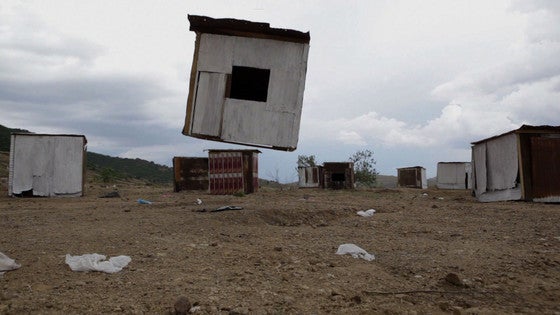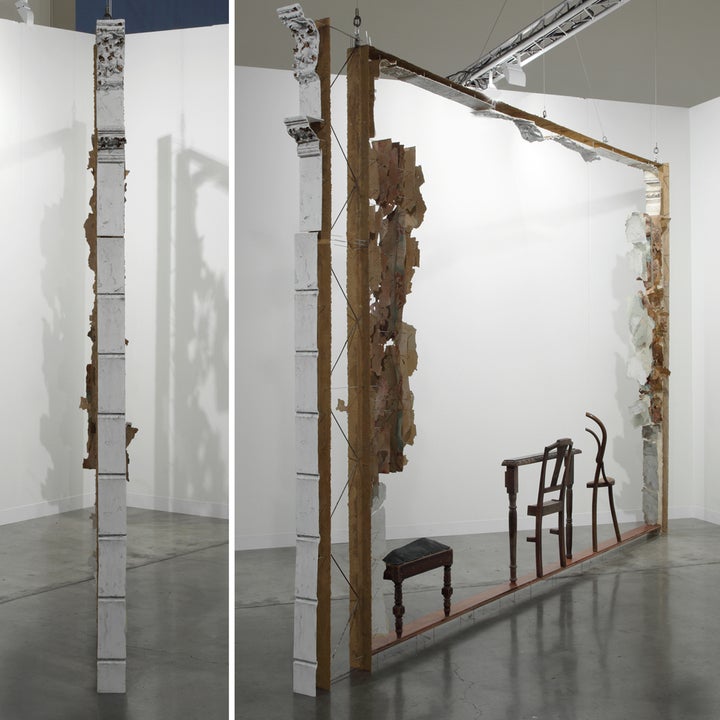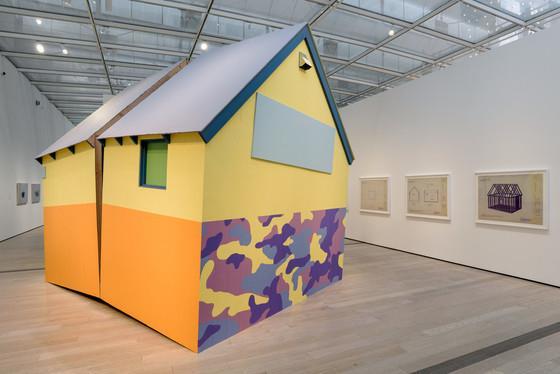
A scene from the video, “The Ghost of Modernity (Lixiviados)” (2012) by the Argentinian artist Miguel Angel Ríos in the show, “Home—So Appealing, So Different”
“Home—So Different, So Appealing,” a truly astonishing show at the L.A. County Museum of Art (LACMA), captures dislocation, exploitation, despair, and division in work after work, in installation after installation. This show doesn’t explode in your face but gradually builds momentum with searing and striking images about poverty, isolation, discrimination, and death, the very things most people avoid, deny, or ignore. It’s intellectually rich and truly emotional, a multimedia exhibition where the hallowed concept and fluid context of home is dissected, split, deconstructed, and even floated in the air. At almost every turn and angle we find a fresh insight and a new revelation.
There is a fierce war of ideas taking place in the world right now between those who want to go forward and those who want to go backward. We see the signs of this in our own political discourse here in the States as well as throughout the world. Authoritarian forces are fighting on every front to set a regressive course while those who believe in freedom and the right to self-expression are making their own case. By virtue of the times we are living in, this show is on the frontline of that war and the artists gathered here in one place for one moment in Los Angeles are making the case for freedom in every sense through their art.
The fact that the artists are all Latino and Latin American is simply a fact, not the focus. Yes, the curators brought together these artists—whose works span several decades and art movements as well as cultural and national origins—because they are Latino or Latin American. That’s true. Perhaps the curators are making the case that modern and post-modern art in its myriad forms has been made at the highest levels by Latinos and Latin Americans. Period. But the overriding aim is to showcase the art created by these artists not their race or ethnic identity. In this way, “Home” goes far beyond the usual ethnic shows that offer nostalgic or stereotypical images of what it means to be something different. This show boldly presents strong aesthetic statements by exemplary artists.
“The Ghost of Modernity (Lixiviados)” (2012) by the Argentinian artist Miguel Angel Ríos is perfectly titled and one of the show’s standout works. To fully appreciate this piece, it helps to know what the Spanish word lixiviados means. Lixiviados are leachates, which are contaminated liquid materials usually found in landfills or dumpsites that are environmentally harmful especially when released into the atmosphere. Thus, modernity and its ghost, which in Ríos’ video, is a transparent cube that floats above and around the wooden and metal shacks that have landed from above with a thud amid the trash and detritus produced by our contemporary disposable society. The cube represents the ghostliness of space and the presence of invisibility. The video’s sound effects are just as jarring as the visual scenes themselves, especially at the end when women sweep the ground with hand-made straw brooms with an incessant scratching sound as if they were conducting a ritual meant to wipe away modernity with its contaminating ensemble of normative thinking and behavior.

“Excision” (2012) by Leyla Cardenas in “Home—So Appealing, So Different”
The show’s theme of home comes together particularly well in one room where deconstructed animal-like furry furniture by the Latino American artist Raphael Montañez Ortiz is juxtaposed with a delicate centerpiece by Leyla Cardenas, a Colombian artist, who carefully sliced away and preserved a 4-inch piece of a wall and room from a 19th century house in Bogotá. The preserved specimen is composed of remnants of wallpaper, a wooden chair, table, floor, and a fluttering strip of ceiling. The thin, torn series of sheets of wallpaper represent the generations of people who have lived in a house and remind us of where we came from and the fragility of mortal memory. Together the works by these two artists create a sense of the fiber and fabric of the inner life of home and soul. This is a view of home from the inside out. Quite brilliant.
Another exceptional piece is by the U.S. Latino artist Daniel Joseph Martinez. “The House America Built” is an exact replica of the infamous Unabomber’s Thoreau-inspired cabin in the Montana woods but split in half and brightly painted in the Martha Stewart Signature Paint 2017 color scheme down to a side panel in camouflage in a sweet and upbeat palette that mocks the militaristic nature of the Unabomber’s dirty work. Your eyes are drawn to the curiously unbalanced cabin in much the same way that a colorful children’s playground and its toys might draw your attention but once you realize what it is, the dwelling of a violent intellectual and madman, a feeling of disquiet may arise. The Unabomber’s Manifesto is nearby in case you want to understand the ideas that drove his murderous obsessions.

“The House That America Built,” (2004/2017) by Daniel Joseph Martinez in “Home—So Appealing, So Different”
“Home” is the first exhibition of the Getty Foundation’s Pacific Standard Time: Los Angeles/Latin America (PST: LA/LA) series of shows opening in Fall 2017. It sets such a high standard (no pun intended) that it will be interesting to see what the other exhibitions have to offer. While there are a few minor works and a couple of pieces in the show that while interesting do not rise to the occasion, this is still a major thematic exhibition of rare artistic quality not often seen gathered in one place.
The three co-curators of this show—Chon Noriega, Mari Carmen Ramirez, and Pilar Tompkins Rivas—have pulled off a major global artistic statement with “Home.”
The Sufi poet Rumi wrote that there are a thousand ways to go home again. This show lets you go home in so many profound and unexpected ways that the lingering impact makes it an unforgettable experience.
